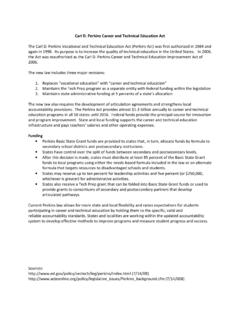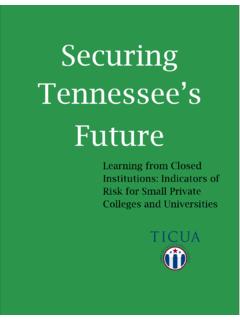Transcription of High School Career Academies: A 40-Year Proven …
1 high School Career academies : A 40-Year Proven Model for improving college and Career readiness By Betsy Brand Executive Director, American Youth Policy Forum Commissioned by The National Career Academy Coalition to commemorate the 40th anniversary of Career academies In Partnership with Association of Career and Technical Education Buck Institute for Education Capture Educational Consulting Services Career Academy Support Network, University of California, Berkeley Center on Education and Work, University of Wisconsin-Madison ConnectEd: The California Center for college and Career MDRC National Academy Foundation National Association of Secondary School Principals National Association of State Directors of Career Technical Education Consortium National Partnership for Careers in Law, Public Safety, Corrections and Security Philadelphia academies , Inc.
2 Southern Regional Education Board/ high Schools That Work November 2009 2 high School Career academies : A 40-Year Proven Model for improving college and Career readiness Need for Action espite many well-intentioned School reform efforts, many high School students continue to leave high School unprepared for college -level work or careers. Nationwide, only about 70% of students graduate from high School in four years. Dropout rates are even higher in many urban areas and also for African American and Latino Those without a high School diploma earn significantly less ($1 million over their working life) than those with a college Additionally, 42% of America s community college freshmen and 20% of freshmen in four- year institutions must take at least one remedial college Those numbers are even more troubling considering that students who take remedial classes are less likely to complete a postsecondary When one considers that more and more jobs in the global economy require some type of postsecondary education or training, these statistics have serious implications for the labor force and the quality of life of our citizens.
3 To address these issues, state and local policymakers have been piloting various strategies to improve high School success rates. These include increasing academic rigor, making School more relevant to students lives, and ensuring that students have stronger, supportive relationships with adults. Accordingly, there have been changes in longtime policies which include increasing the mandatory School attendance age and the number of courses required for high School graduation and raising standards and aligning them with college entrance requirements. There have also been efforts to create smaller learning communities, expand and improve Career and technical education, and implement accelerated learning programs.
4 Some policymakers, particularly at the School district level, are also exploring the use of multiple pathways (various types of schools and programs) to meet the diverse needs of youth. To date, state and local policymakers have taken the lead on high School reform and improving college and Career readiness . But President Obama s goal of expanding access to a college education is changing that. Policymakers at the national level are increasingly focused on reducing the number of high School dropouts and improving prospects for college and Career success. The Obama Administration has requested new funding streams in the FY 2010 budget that support initiatives in these areas.
5 Additionally, several legislative proposals have been introduced in Congress aimed at improving high School graduation rates and college and Career readiness . Given the Administration s policy focus, it is very likely that DCareer academies are a time-tested model for improving academic achievement readying students for both college and careers, and engaging the world outside of School in the work of reforming them. As lawmakers work to craft policies that will dramatically improve American public education, Career academies should be recognized for their effectiveness and included in reform efforts. 3 lawmakers attention to these issues will continue to grow.
6 Career academies : A Widely-Used Reform Model n analyzing various high School reform efforts that have been employed nationwide, the Career academy model has emerged as a strategy that works to improve student outcomes. Originally conceived forty years ago, Career academies address academic rigor, relevance of instruction, and build relationships between students and adults. Career academies have thrived because of their dual objectives of Career and college preparation, the broad cross section of students they serve, the evidence of their success, and the deep relationship between research and practice. A Career academy is commonly defined as a smaller learning community (SLC) within a larger high School which: Is comprised of a group of students that takes classes together for at least two years and is taught by a team of teachers from different disciplines.
7 Provides college preparatory curriculum based on a Career theme that helps students see relationships and connections between academic subjects and their application in the real world of work and a specific Career pathway. Develops partnerships with employers, the community, and colleges which draw upon their resources and increases opportunities for students to engage in internships and work-based learning and provides adult mentors to motivate students and spur Career academies have been widely adopted across the United States, and as a smaller learning community model, Career academies are a popular approach to reform. According to the Department of Education s Smaller Learning Communities Award Database, a total of 1,535 schools in 634 School districts received grants from 2000-2007,6 and approximately 60% of the schools that received a SLC grant in years 2000-2004 used the funding to create a Career In the 2004 National Center for Education Statistics Schools and Staffing Survey, 4,800 high schools nationwide reported having at least one Career academy, defined as a multi- year program in which the curriculum integrates academic and Career /technical education courses organized around one or more broad Career themes.
8 8 Several states have legislation supporting Career academies . California provides support through multiple funding streams for nearly 500 Partnership [ Career ] academies at hundreds of high Many School districts, often in large urban areas, either have networks of academies or have broken all high schools into SLCs, many of which are Career academies . Miami-Dade County Public Schools, the New York City Department of Education, and the Houston Independent School District are just a few urban systems that have supported and promoted the Career academy model as a major strategy of their high School reform efforts. While no one has a precise count, a reasonable estimate is that there are now about 1,000,000 students in Career academies nationwide.
9 Career academies are also widely supported by the business community which sees value in the skills and knowledge students learn during their Career academy years. Employers from all size companies contribute substantial time and resources to support Career academies by serving as curriculum advisors, providing internships and work-based learning opportunities for students, advising and mentoring youth, exposing them to Career fields, and encouraging them to pursue postsecondary education. These contributions from employers and local chambers of commerce provide needed resources to Career academies and schools and improve the quality of education for youth.
10 I Originally conceived forty years ago, Career academies address academic rigor, relevance of instruction, and build relationships between students and adults. Career academies have thrived because of their dual objectives of Career and college preparation, the broad section of students they serve, the evidence of their success, and the deep relationship between research and practice. 4 Career academies also help students develop skills beyond academic achievements that are important to Career and life success. Experiences in the workplace and with employers allow students to experience real work and see beyond the classroom. Student who are given opportunities to work in teams on real projects begin to understand the importance of professionalism, reliability, teamwork, and clear oral communication skills.










